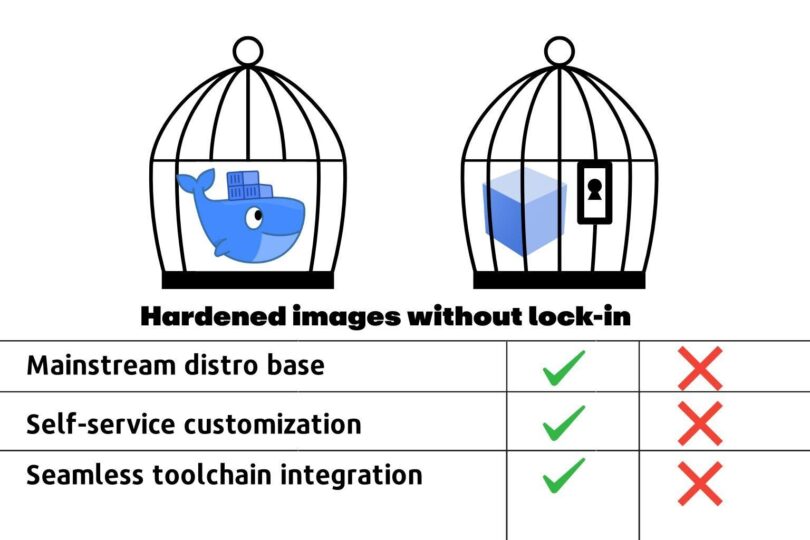
The market for pre-hardened container images is experiencing explosive growth as security-conscious organizations pursue the ultimate efficiency: instant security with minimal operational overhead. The value proposition is undeniably compelling—hardened images with minimal dependencies promise security “out of the box,” enabling teams to focus on building and shipping applications rather than constantly revisiting low-level configuration management.
For good reason, enterprises are adopting these pre-configured images to reduce attack surface area and simplify security operations. In theory, hardened images deliver reduced setup time, standardized security baselines, and streamlined compliance validation with significantly less manual intervention.
Yet beneath this attractive surface lies a fundamental contradiction. While hardened images can genuinely reduce certain categories of supply chain risk and strengthen security posture, they simultaneously create a more subtle form of vendor dependency than traditional licensing models. Organizations are unknowingly building critical operational dependencies on a single vendor’s design philosophy, build processes, institutional knowledge, responsiveness, and long-term market viability.
The paradox is striking: in the pursuit of supply chain independence, many organizations are inadvertently creating more concentrated dependencies and potentially weakening their security through stealth vendor lock-in that becomes apparent only when it’s costly to reverse.
The Mechanics of Modern Vendor Lock-in
Unfamiliar Base Systems Create Switching Friction
The first layer of lock-in emerges from architectural choices that seem benign during initial evaluation but become problematic at scale. Some hardened image vendors deviate from mainstream distributions, opting to bake their own Linux variants rather than offering widely-adopted options like Debian, Alpine, or Ubuntu. This deviation creates immediate friction for platform engineering teams who must develop vendor-specific expertise to effectively manage these systems. Even if the differences are small, this raises the spectre of edge-cases – the bane of platform teams. Add enough edge cases and teams will start to fear adoption.
While vendors try to standardize their approach to hardening, in reality, it remains a bespoke process. This can create differences from image to image across different open source versions, up and down the stack – even from the same vendor. In larger organizations, platform teams may need to offer hardened images from multiple vendors. This creates further compounding complexity. In the end, teams find themselves managing a heterogeneous environment that requires specialized knowledge across multiple proprietary approaches. This increases toil, adds risk, increases documentation requirements and raises the cost of staff turnover.
Compatibility Barriers and Customization Constraints
More problematic is how hardened images often break compatibility with standard tooling and monitoring systems that organizations have already invested in and optimized. Open source compatibility gaps emerge when hardened images introduce modifications that prevent seamless integration with established DevOps workflows, forcing organizations to either accept reduced functionality or invest in vendor-specific alternatives.
Security measures, while well-intentioned, can become so restrictive they prevent necessary business customizations. Configuration lockdown reaches levels where platform teams cannot implement organization-specific requirements without vendor consultation or approval, transforming what should be internal operational decisions into external dependencies.
Perhaps most disruptive is how hardened images force changes to established CI/CD pipelines and operational practices. Teams discover that their existing automation, deployment scripts, and monitoring configurations require substantial modification to accommodate the vendor’s approach to security hardening.
The Hidden Migration Tax
The vendor lock-in trap becomes most apparent when organizations attempt to change direction. While vendors excel at streamlining initial adoption—providing migration tools, professional services, and comprehensive onboarding support—they systematically downplay the complexity of eventual exit scenarios.
Organizations accumulate sunk costs through investments in training and vendor-specific tooling that create psychological and financial barriers to switching providers. More critically, expertise about these systems becomes concentrated within vendor organizations rather than distributed among internal teams. Platform engineers find themselves dependent on vendor documentation, support channels, and institutional knowledge to troubleshoot issues and implement changes.
The Open Source Transparency Problem
The hardened image industry leverages the credibility of open source. But it can also undermine the spirit of open source transparency by creating almost a kind of fork but without the benefits of community.. While vendors may provide source code access, this availability doesn’t guarantee system understanding or maintainability. The knowledge required to comprehend complex hardening processes often remains concentrated within small vendor teams, making independent verification and modification practically impossible.
Heavily modified images become difficult for internal teams to audit and troubleshoot. Platform engineers encounter systems that appear familiar on the surface but behave differently under stress or during incident response, creating operational blind spots that can compromise security during critical moments.
Trust and Verification Gaps
Transparency is only half the equation. Security doesn’t end at a vendor’s brand name or marketing claims. Hardened images are part of your production supply chain and should be scrutinized like any other critical dependency. Questions platform teams should ask include:
- How are vulnerabilities identified and disclosed? Is there a public, time-bound process, and is it tied to upstream commits and advisories rather than just public CVEs?
- Could the hardening process itself introduce risks through untested modifications?
- Have security claims been independently validated through audits, reproducible builds, or public attestations?
- Does your SBOM meta-data accurately reflect the full context of your hardened image?
Transparency plus verification and full disclosure builds durable trust. Without both, hardened images can be difficult to audit, slow to patch, and nearly impossible to replace. Not providing easy-to-understand and easy-to-consume verification artefacts and answers functions as a form of lock-in forcing the customer to trust but not allowing them to verify.
Building Independence: A Strategic Framework
For platform teams that want to benefit from the security gains of hardened images and reap ease of use while avoiding lock-in, taking a structured approach to hardened vendor decision making is critical.
Distribution Compatibility as Foundation
Platform engineering leaders must establish mainstream distribution adherence as a non-negotiable requirement. Hardened images should be built from widely-adopted distributions like Debian, Ubuntu, Alpine, or RHEL rather than vendor-specific variants that introduce unnecessary complexity and switching costs.
Equally important is preserving compatibility with standard package managers and maintaining adherence to the Filesystem Hierarchy Standard (FHS) to preserve tool compatibility and operational familiarity across teams. Key requirements include:
- Package manager preservation: Compatibility with standard tools (apt, yum, apk) for independent software installation and updates
- File system layout standards: Adherence to FHS for seamless integration with existing tooling
- Library and dependency compatibility: No proprietary dependencies that create additional vendor lock-in
Enabling Rapid Customization Without Security Compromise
Security enhancements should be architected as modular, configurable layers rather than baked-in modifications that resist change. This approach allows organizations to customize security posture while maintaining the underlying benefits of hardened configurations.
Built-in capability to modify security settings through standard configuration management tools preserves existing operational workflows and prevents the need for vendor-specific automation approaches. Critical capabilities include:
- Modular hardening layers: Security enhancements as removable, configurable components
- Configuration override mechanisms: Integration with standard tools (Ansible, Chef, Puppet)
- Whitelist-based customization: Approved modifications without vendor consultation
- Continuous validation: Continuous verification that customizations don’t compromise security baselines
Community Integration and Upstream Collaboration
Organizations should demand that hardened image vendors contribute security improvements back to original distribution maintainers. This requirement ensures that security enhancements benefit the broader community and aren’t held hostage by vendor business models.
Evaluating vendor participation in upstream security discussions, patch contributions, and vulnerability disclosure processes provides insight into their long-term commitment to community-driven security rather than proprietary advantage. Essential evaluation criteria include:
- Upstream contribution requirements: Active contribution of security improvements to distribution maintainers
- True community engagement: Participation in security discussions and vulnerability disclosure processes
- Compatibility guarantees: Contractual requirements for backward and forward compatibility with official distributions
Intelligent Migration Tooling and Transparency
AI-powered Dockerfile conversion capabilities should provide automated translation between vendor hardened images and standard distributions, handling complex multi-stage builds and dependency mappings without requiring manual intervention.
Migration tooling must accommodate practical deployment patterns including multi-service containers and legacy application constraints rather than forcing organizations to adopt idealized single-service architectures. Essential tooling requirements include:
- Automated conversion capabilities: AI-powered translation between hardened images and standard distributions
- Transparent migration documentation: Open source tools that generate equivalent configurations for different providers
- Bidirectional conversion: Tools that work equally well for migrating to and away from hardened images
- Real-world architecture support: Accommodation of practical deployment patterns rather than forcing idealized architectures
Practical Implementation Framework
Standardized compatibility testing protocols should verify that hardened images integrate seamlessly with existing toolchains, monitoring systems, and operational procedures before deployment at scale. Self-service customization interfaces for common modifications eliminate dependency on vendor support for routine operational tasks.
Advanced image merging capabilities allow organizations to combine hardened base images with custom application layers while maintaining security baselines, providing flexibility without compromising protection. Implementation requirements include:
- Compatibility testing protocols: Standardized verification of integration with existing toolchains and monitoring systems
- Self-service customization:: User-friendly tools for common modifications (CA certificates, custom files, configuration overlays)
- Image merging capabilities: Advanced tooling for combining hardened bases with custom application layers
- Vendor SLAs: Service level agreements for maintaining compatibility and providing migration support
Conclusion: Security Without Surrendering Control
The real question platform teams must ask is this. Does my hardened image vendor strengthen or weaken my own control of my supply chain? The risks of lock-in aren’t theoretical. All of the factors described above can turn security into an unwanted operational constraint. Platform teams can demand hardened images and hardening process built for independence from the start— rooted in mainstream distributions, transparent in their build processes, modular in their security layers, supported by strong community involvement, and butressed by tooling that makes migration a choice, not a crisis.
When security leaders adopt hardened images that preserve compatibility, encourage upstream collaboration, and fit seamlessly into existing workflows, they protect more than just their containers. They protect their ability to adapt and they minimize lock-in while actually improving their security posture. The most secure organizations will be the ones that can harden without handcuffing themselves.



